1862 Homestead Act. Studying the Land Office Clerk’s massive four-page, 5′ x 5′ map of L.A. County, the women pointed to two parcels of unclaimed land in Topanga Canyon, amid the wilds of the Santa Monica Mountains.
According to historian Josh Sides, author of the new book Backcountry Ghosts: California Homesteaders and the Making of a Dubious Dream, the clerk doubted the women could survive on the unforgiving homestead. “I admire your courage,” he said, “but to be perfectly honest, I think you are attempting the impossible.”
The women were not deterred. “When my daughter and I came to Los Angeles we were absolute strangers,” Friederich told the Los Angeles Times. “We came out here from St. Louis because our health was failing. My daughter, who has a college education, secured employment, but her health failed and she decided to give it up. So we decided that the mountains was the place for us. We took up this land. After securing the paper establishing our right to the property, we went out to build a home. It meant hard work but my daughter is young and brave, and she only laughed at all my objections.”
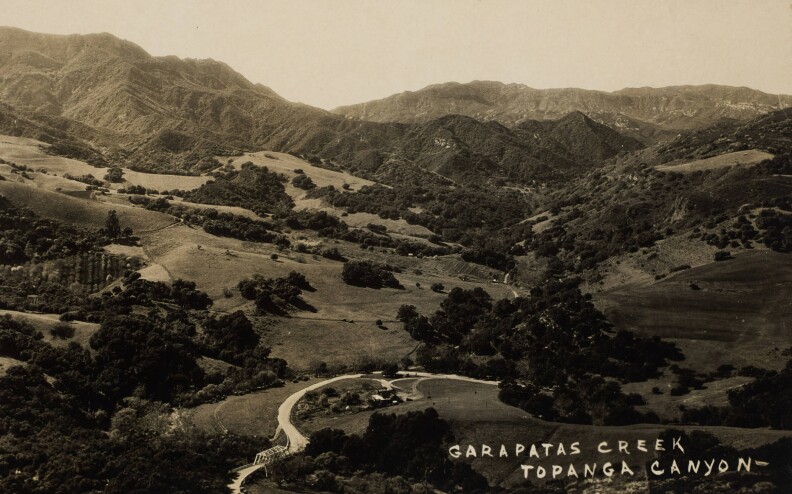
Garapatas Creek in Topanga Canyon. Circa 1920s.
Huntington Digital Library
)
Soon, the Friederich women had built two small houses and planted eight acres of crops on their property, more than enough to secure the land permanently under the Homestead Act.
Signed by President Abraham Lincoln on May 20, 1862, the Homestead Act transformed the American West, enticing small farmers and ranchers to fulfil the country’s dubious policy of Manifest Destiny. “In so far as the Government lands can be disposed of, I am in favor of cutting up the wild lands into parcels, so that every poor man may have a home,” Lincoln said.
According to the National Archives, the Act gave citizens, and those eligible for future citizenship, parcels of up to 160 acres of government land (enlarged to 320 acres in 1909) for a small registration fee. The homesteaders then had five years to “prove up the land” by establishing primary residency, building a home at least 12′ x 14′ and improving the soil. If they succeeded, the land became theirs after five years.

The Avila Adobe Homestead on Olvera Street. June 25, 1928.
California Historical Society/University of Southern California, Libraries
)
The U.S. government granted more than 270 million acres of land under the Homestead Act before the law was repealed in 1976. The bulk of it was deeded between 1863 and 1934.
In the Golden State, the program was wildly popular. According to Sides, approximately 60,000 homesteaders were successful in proving up their claims in California and 10% of the state’s land was homesteaded. People claimed 2,852 homesteads in Los Angeles County.
“Down in Hollywood, several homesteaders became rich growing wheat and then climbing the property ladder. Though there were very few homesteads in Los Angeles proper, there were hundreds in the Santa Monica Mountains, the Antelope Valley and along the foothills of the San Gabriel Mountains out past Pasadena,” Sides says.
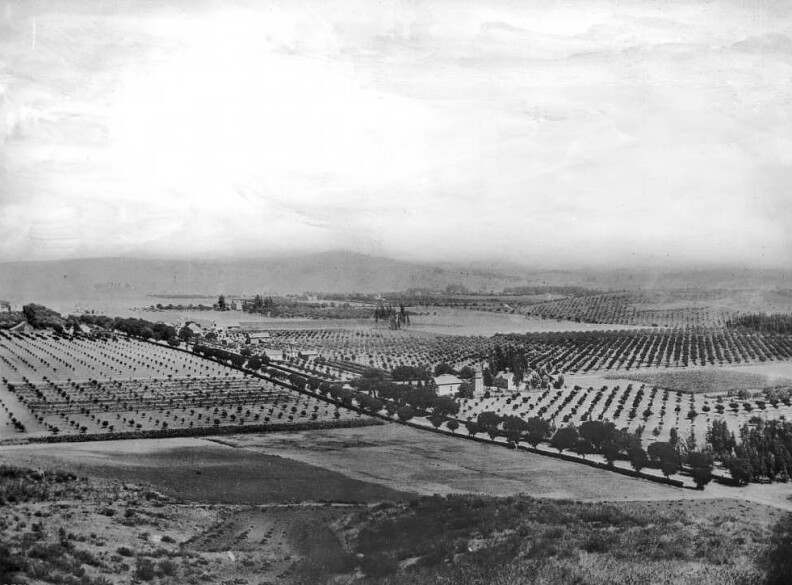
Panorama of East Hollywood from Laughlin Park. 1901.
California Historical Society/University of Southern California, Libraries
)
Sides started his historical journey through California’s homesteading history after he was introduced to Rose Trujillo Wiley. Born in 1931, her grandfather, Francisco, had homesteaded a plot in Topanga Canyon in 1886. More than 100 years later, in 2011, Wiley was still living on the property.
“It seemed so improbable that people were given free land in very expensive Los Angeles and throughout very expensive California, but more than 60,000 folks proved up their claims in California and secured millions of acres of public land,” Sides says.
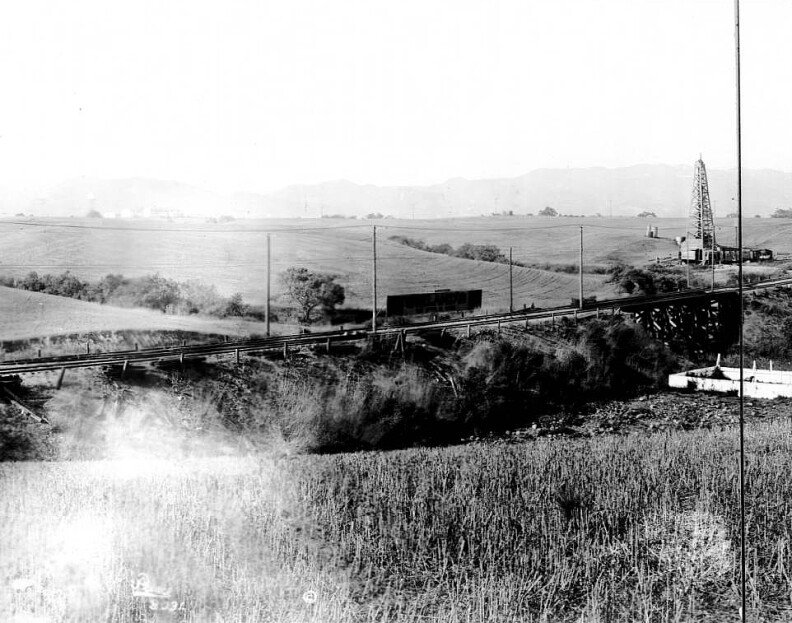
A panoramic view of farmland on Santa Monica Blvd., looking east. 1904.
California Historical Society/University of Southern California, Libraries
)
The Los Angeles Land Office would become the busiest land office in the state, issuing patents for California’s four most popular counties: Kern, San Bernardino, San Diego and Los Angeles. The city of L.A. itself had fewer than 20 available homesteads, mostly in Hollywood and East Hollywood (then known as the Cahuenga Valley), and centered around Normandie Avenue. One of the most successful Hollywood homesteaders was Ivar A. Weid (namesake of Ivar Avenue), known for his “untiring energy and liberality.” He developed a sprawling ranch of fruit trees and wheat, amassing a small fortune.
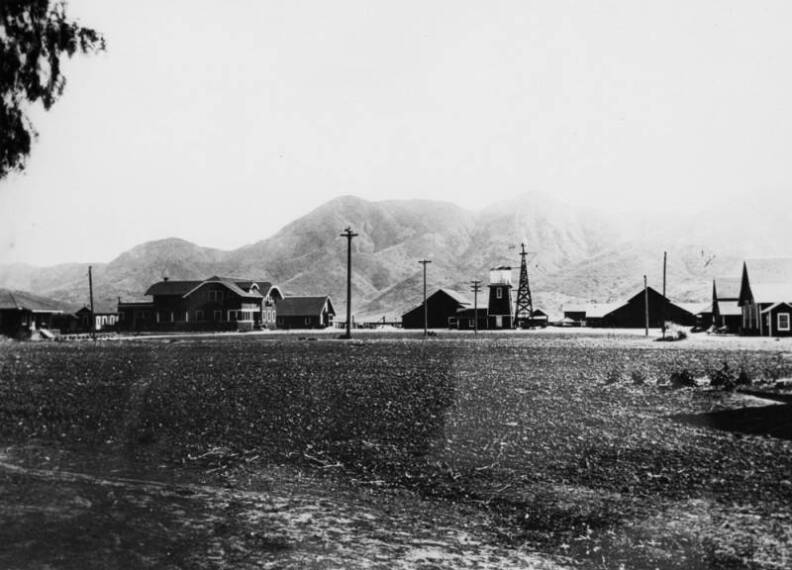
A panoramic view of a ranch homestead and its fields, located in Camarillo. The exact location of this ranch is unidentified.
Security Pacific National Bank Collection/Los Angeles Public Library Collection
)
Not all homesteaders were so successful. Despite the claim of “free land” for the taking, it wasn’t a cheap proposition. According to Sides, in 1909 Arthur H. Dutton wrote in the San Francisco Chronicle:
“At the lowest possible standard of living for an American, $750 in cash is the least amount that the prospective homesteader, a single man, should have on hand before he makes his first settlement on the land. After that he may be able to earn a living from the land itself, but that amount is essential at the start. It will give him but the barest necessities. A thousand dollars will be needed for a man with a family. Fifteen hundred dollars will give some sense of security to a single man and $2500 to a man of family.”
Many homesteaders went broke attempting to cultivate their land, leading to a popular poem:
Jim Travers had the sort of wealth
That comes where lands are wide,
Jim Travers had a homestead —
And not much else beside.
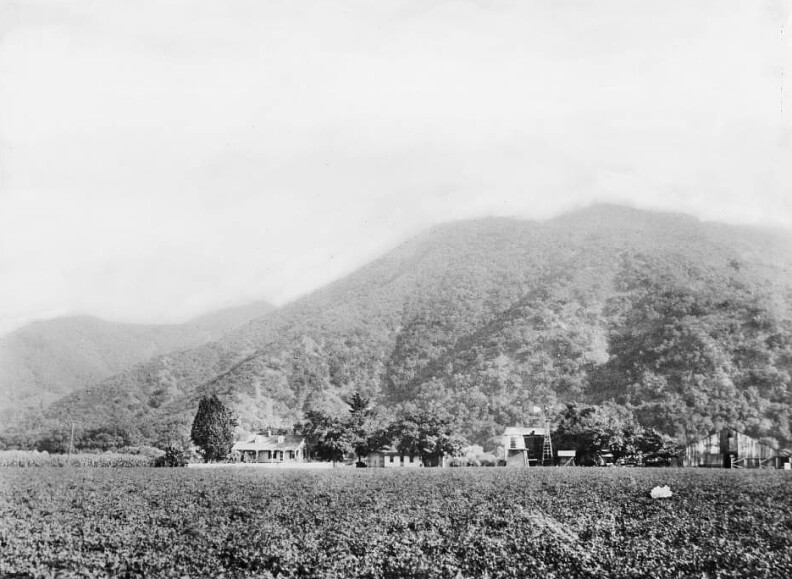
Exterior view of Dr. David Burbank’s home at Dark Canyon Pass, Burbank. Circa 1910.
California Historical Society/University of Southern California, Libraries
)
Despite the high cost of entry, which made it impossible for many people to participate, the program was open to a large number of Americans including Black people, women and most immigrants. Due to racism, Asian immigrants, who had come to the U.S. to build railroads but had been barred from becoming citizens, were unable to participate in homesteading. Also barred were the indigenous people from whom this “public land” had been stolen, since they too were barred from becoming American citizens.
“Homesteading was a tough way to live, nothing romantic about it, but it gave many struggling Americans as well as recent immigrants from Ireland, Germany and Mexico an opportunity to own land. The Homestead Act was the most sweeping act of American social policy before the Social Security Act/New Deal, and it fulfilled an earlier Jeffersonian vision of a more egalitarian society based on universal property ownership,” Sides says.
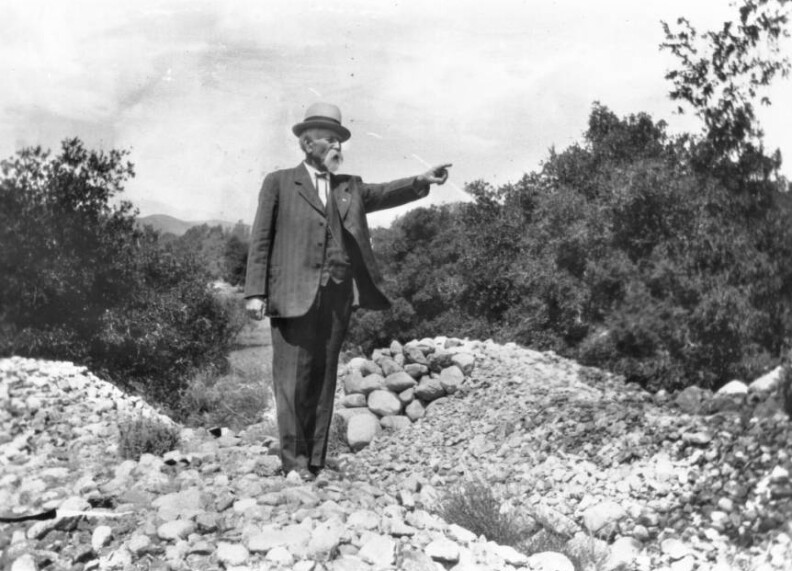
Charles J. Prudhomme, photographer, stands on the spot in Placerita Canyon where the first gold was discovered in California in 1842 by Francisco Lopez. 1931.
California Historical Society/University of Southern California, Libraries
)
In Southern California, many descendants of Californios, the Spanish-Mexican aristocracy who had ruled during California’s colonial days, attempted to recover their families’ lost fortunes through homesteading. According to Sides, members of the famous Verdugo, Figueroa and Noriega families settled around the Santa Clarita River while Italian, Polish and Jewish families homesteaded near Placerita Canyon. Today, the Placerita Canyon State Park sits on land once owned by the homesteading Walker family, which had come from the French Alps. One of their original cabins is preserved at the Placerita Canyon Nature Center.
Many formerly enslaved people who came out West to build new lives also became homesteaders. According to the National Parks Service, pioneering filmmaker Oscar Micheaux drew on his experience as the only Black man homesteading in South Dakota to write and direct The Homesteader a 1919 film thought to be the first feature by a Black director. Sadly, the film has been lost.
In Los Angeles, Black pioneer John Ballard also claimed a homestead after a lifetime of firsts. In John Ballard and the African American Community in Los Angeles, 1850-1905, author Patty R. Colman explains that Ballard was probably born enslaved and came to Los Angeles in the 1850s. He soon established himself as a successful businessman, buying and selling real estate. Along with Biddy Mason, he helped found the First A.M.E church and he became one of the first Black men to vote in L.A. County.
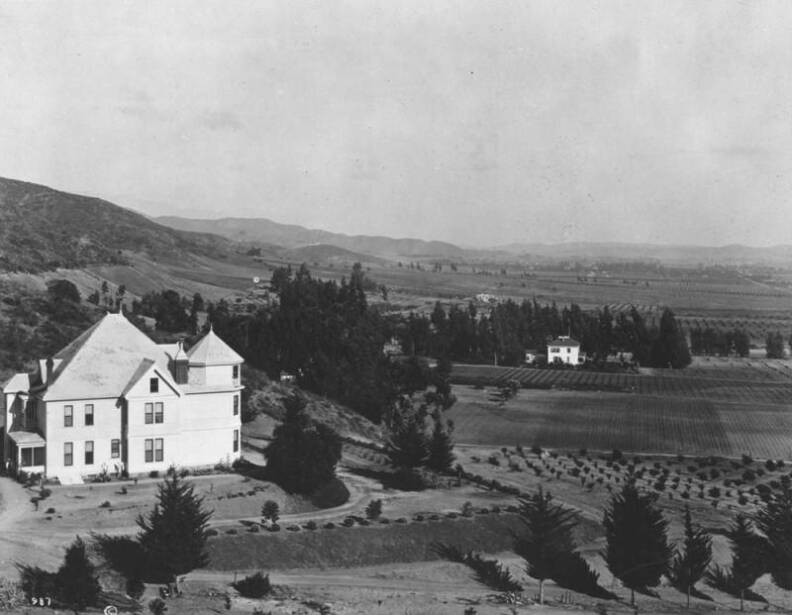
The Harper Homestead is on the left in this view of West Hollywood and the Cahuenga Valley looking east from Laurel Canyon and Sunset Boulevard. Circa 1900-1906.
Security Pacific National Bank Collection/Los Angeles Public Library Collection
)
By the 1870s, Ballard had fallen on hard times. His first wife passed away, leaving him with a large number of children and he lost a large chunk of money in a real estate deal. Newly remarried, in 1880 he escaped to Triunfo Creek in the Santa Monica Mountains (in present day Agoura), buying land dotted with hot springs then homesteading adjacent properties.
There, the strong, powerful Ballard, who loved to sing, cultivated crops and a vineyard on his land, often facing racism from his fellow homesteaders. According to Colman’s book, a fellow homesteader recalled the kindness of his wife, Francis, who “would always make biscuits and she had wild grapes pre-served in honey. Perhaps because we were young and hungry, I have always thought I’ve never eaten anything so good.”
His home was nicknamed the pejorative “N-word” Mountain and known as Negrohead Mountain until 2010, when it was renamed Ballard Mountain. His descendants reportedly still visit the site, which now has a plaque off Kanan Road honoring Ballard and his family.
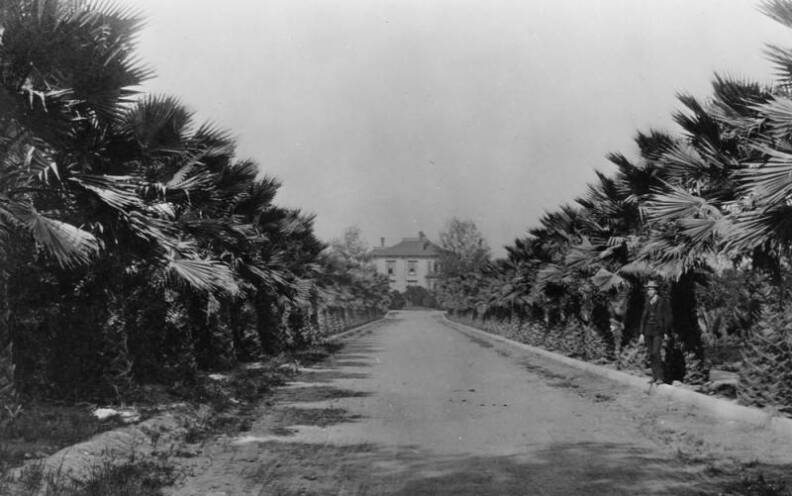
A view of Palm Ave. and Adams St., near Grand Ave. with General Longstreet’s homestead at the far end of the road.
Security Pacific National Bank Collection/Los Angeles Public Library Collection
)
As Southern California became more cosmopolitan, Ballard and his fellow homesteaders became archaic symbols of an earlier era. Ballard was well known in nearby towns, arriving in his rickety, mud-splattered wagon to do business and vote. Nearby, the Trujillo family continued their old-fashioned ways. Although her dad, Delores Trujillo, lived until 1959, “My father never entered the 20th century,” Rose Wiley told Sides.
Homesteaders often resorted to hunting and gathering, growing chickens in coops to supplement their meager diets. Other Santa Monica Mountain homesteaders like Charles Decker invited L.A. society to their rustic properties to illegally hunt for bucks during the off-season. In the Antelope Valley, which was filled with bands of religious homesteaders, residents banded together to bring water to their dry, parched plots of land.
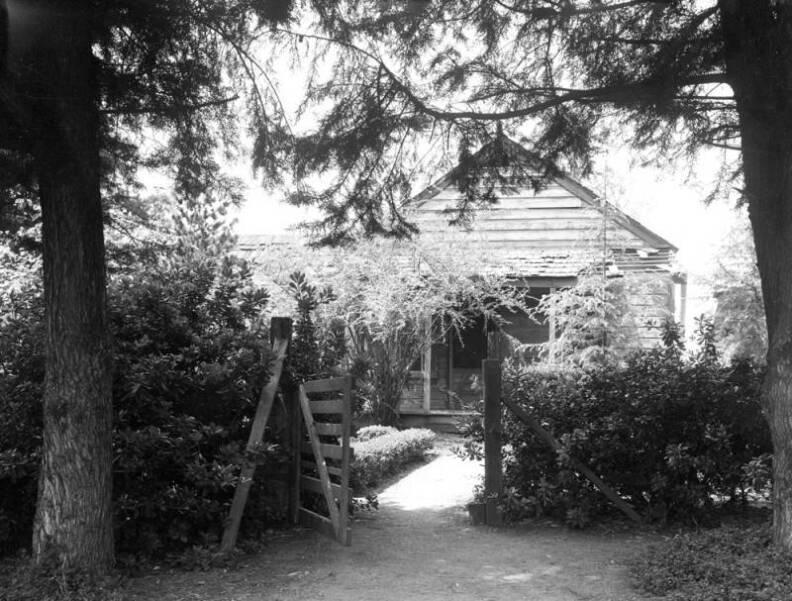
The ranch home of Henry Hancock in the LaBrea Tar Pits area, later Hancock Park. He was an early Los Angeles lawyer, surveyor, land owner and candidate for the Presidency of the United States. Circa 1938.
Works Progress Administration Collection/Los Angeles Public Library Collection
)
Violence was a constant threat. In lawless Calabasas, pistol-packing Anna Leffingwell, a former showgirl with a penchant for marrying men with land, terrorized any fellow homesteaders who dared mess with her property.
Elizabeth and Lizzie Friederich also encountered problems at their plot in the Santa Monica Mountains. A squatter named Moses Crockwell, living on land claimed by the Friedrichs, laughed in their face when they told him to leave. “He cursed and insulted us, using the vilest language I ever heard one use,” Elizabeth said. The Los Angeles Times reported:
“It now appears that even since they began to build their little home, a man has stood in their path. According to the story told by Mrs. Friederich last night, this man has cast his sinister shadow over their homestead, and not only proposes to drive them off, but has actually attempted to take their lives by poisoning the spring from which they have been getting their drinking water.”
According to Elizabeth, Lizzie had fallen violently ill one day after drinking from the family well. “I was morally certain who had done the dastardly work but I went out to investigate. I found footprints around the spring leading off towards the Crockwell house. Then I found an imprint left by Mr. Crockwell’s shoe,” she said.
The Friederichs took Crockwell to court multiple times but the harassment continued. “I confess that I am afraid to live out there at night… My daughter is out there now, alone. She has a gun, and she is brave enough to use it if necessary,” Elizabeth told the court.
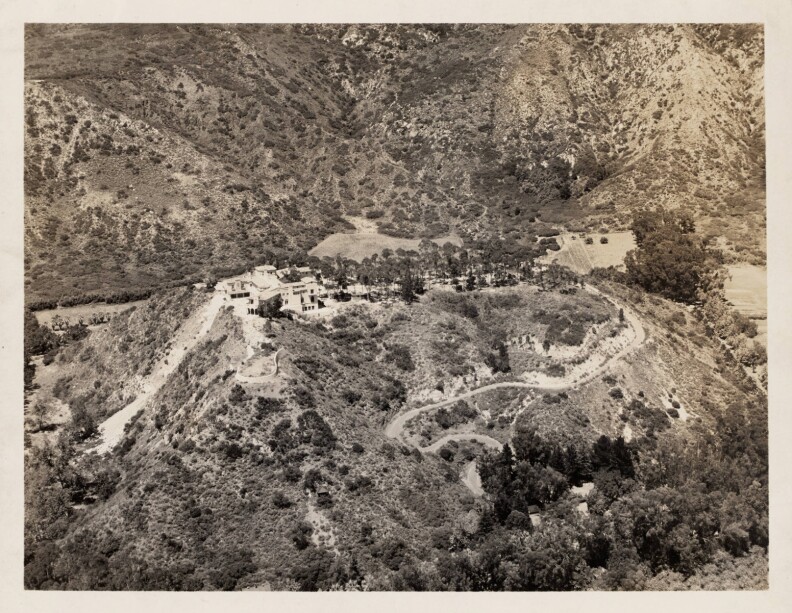
Aerial view of the unfinished mansion and property known as Rindge Castle, on Laudamus Hill in Malibu Canyon, owned by May Knight Rindge. Circa 1932-1935.
Fairchild Aerial Surveys Inc./Huntington Digital Library
)
The more serious challenges to homesteaders came from big business.
“I was surprised by the level of chicanery, violence and brutality many homesteaders endured at the hands of the oil companies, railroad companies, land developers and particularly cattle ranchers. It’s a cliché but no less true that might made right at the turn of the 20th Century. We shouldn’t be surprised that poor men and women struggled to retain their hard-won land but the scale of the transgressions was stunning. Lots of gun play, harassment and even poisoning to dislodge homesteaders from their rightful land,” Sides says.
In the Santa Monica Mountains, the aforementioned Decker family led homesteaders in a decades-long battle with the powerful May Rindge, who owned most of what we now know as Malibu. As described by David K. Randall in The King and Queen of Malibu: The True Story of the Battle for Paradise, the feud, which involved property rights and access to the road that eventually became the Pacific Coast Highway, included armed conflicts, court battles and homesteaders chaining their cars together to trap Rindge inside her mansion.
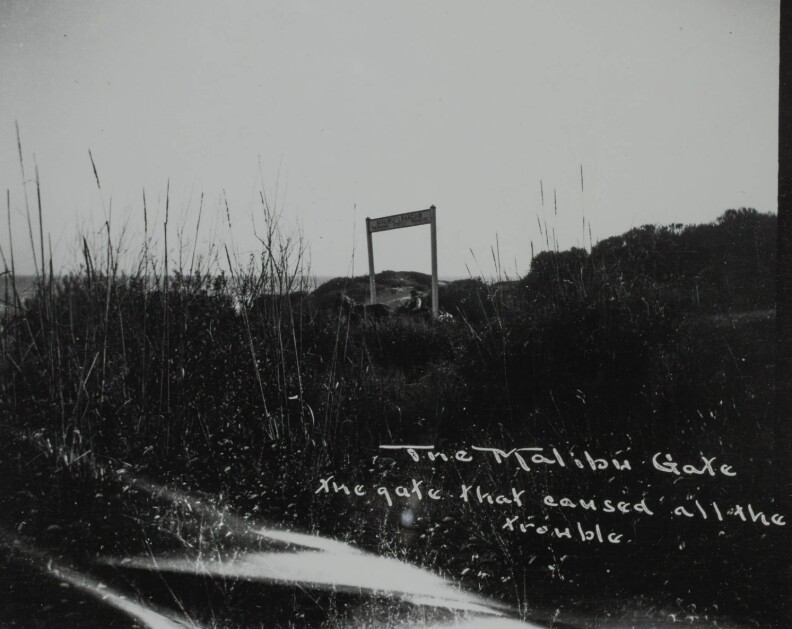
The Malibu gate on May Rindge’s property had a sign that read, “Malibu Rancho – Trespassers Strictly Prohibited,” to discourage travel along the coast.
Huntington Digital Library
)
Much of the violence sprang from murky laws regarding who owned mineral rights to homesteaded land during the interim five-year period. Oil and mining companies often took advantage of this situation, terrorizing homesteaders off valuable plots. Sides described the plight of one Kern County homesteader:
“Bernard L. Snepp — a veteran of the Spanish-American War — awoke to the sound of splitting wood. Outside, 20 workers for the Los Angeles-based Midland Oil Company — convinced there was oil beneath Snepp’s property — tore down his handmade fence and drove a team of mules across his property to begin laying pipes. ‘He rushed over, gun in hand,’ the Petroleum Gazette reported, ‘and he ordered them off, but they laughed at his lone firearm against their score, and consigned him to perdition.'”
While the issue was being settled in court, Snepp took matters into his own hands. “Snepp loaded Midland’s new $18,000 well with dynamite and grinned as it exploded in a shower of oil, dirt and twisted metal,” Sides writes. After this action, Snepp lost his claim.
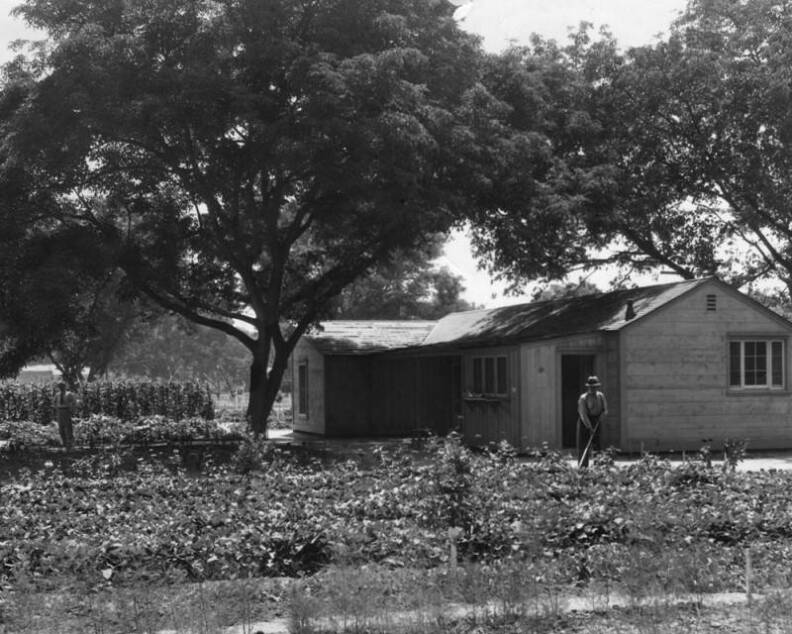
August 1, 1935: “Brightly colored little homes, 100 of them nestling in a walnut grove, were nearing completion in the federal government’s small farm homestead project at El Monte. In a few days the families of white collar and industrial workers chosen to live there will move in. The photo shows a home and garden completed for demonstration purposes. One man, working three hours a day on the acre surrounding it, has raised $75 worth of vegetables and berries since April.”
Herald Examiner Collection/Los Angeles Public Library Collection
)
Homesteading feuds could turn deadly. In 1877, prominent Ventura landowner Thomas Wallace More was murdered by a group of masked homesteaders after a long battle over land rights. Public sentiment often rested with the hardscrabble homesteaders who were seen as modern day Davids battling the Gilded Age’s robber baron Goliaths. The Los Angeles Times editorialized:
“An American’s home should be his castle… the right to a quarter section of land – to a homestead – is one of the few privileges remaining to a poor man in this country, which should be most jealously guarded. Between land-grabbers and railroad companies and speculators, that right is becoming rapidly endangered… Let land-grabbers and speculators take warning… and keep their grasping fingers off of the homes of honest settlers.”
As available land was snapped up, homesteaders ventured deeper into the California desert. According to Sides, in 1931, L.A. Times columnist Harry Carr was surprised to see many homesteaders in the unforgiving Mojave Desert while on a helicopter ride. “Nearly the whole area of the Valley of Twenty-Nine Palms,” he wrote, “has been pre-empted by homesteaders. Their cabins dot the landscape.”
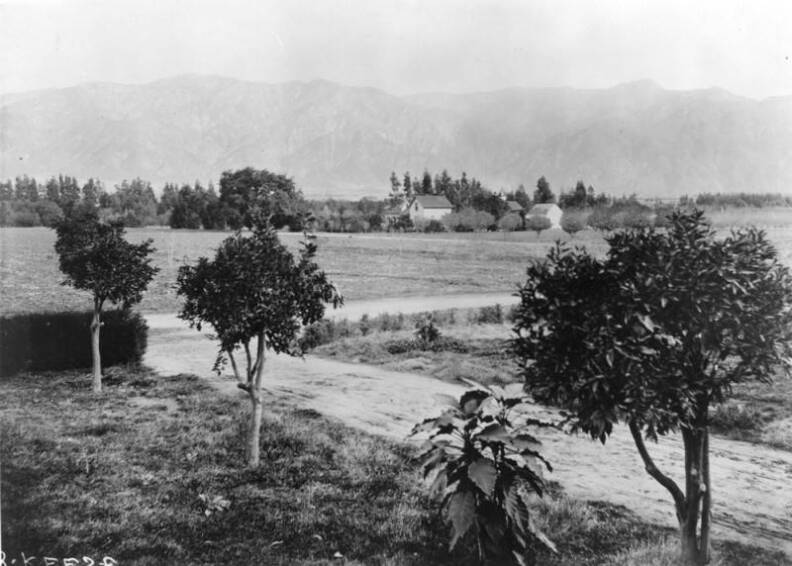
A panoramic view of a Burbank ranch homestead and its fields. The mountains can be seen in the background. Date unknown.
Security Pacific National Bank Collection/Los Angeles Public Library Collection
)
This truly was America’s last frontier. By the 1930s, most of the public land available to homesteaders was gone. Amazingly, according to HISTORY, the Homestead Act was not officially repealed by Congress until 1976. As government initiatives go, it had helped transform Southern California into an agricultural powerhouse of small landowners — at least for a while.
For Sides, Southern California’s homesteading history foreshadowed today’s insanely competitive, unequal real estate market.
“There was a time that the federal government took seriously the notion that it could get struggling people onto land so they could sustain themselves and hopefully make a profit,” Sides says. “It was a bold vision, inspired by a rough egalitarianism. I think we can learn from that kind of broad, humane housing policy.”

March 11, 1948: The Security-First National bank of North Hollywood, of which Fred Weddington is vice president, sits at Lankershim Blvd. and Weddington St. The building stands on property once occupied by the old Weddington homestead.
Valley Times Collection/Los Angeles Public Library Collection
)
Source: laist.com

Leave a Reply